With property prices in India’s metro cities continuing to soar, many potential homebuyers and investors are faced with a critical decision: should they invest in tier 2 or tier 3 cities? While the allure of investing in cities like Mumbai, Delhi, and Bangalore remains strong, the real estate ecosystem offers a wealth of opportunities beyond these tier 1 cities. Tier 2 and tier 3 cities, experiencing rapid urbanization and economic growth, have emerged as hotspots for real estate investment. In this article, we will explore the potential of these cities, the factors driving their growth, and the challenges and considerations for investors looking to capitalize on these emerging markets.
Understanding Tier 2 and Tier 3 Cities
Before delving into the specifics, it is essential to understand the classification of tier 2 and tier 3 cities. These classifications are typically based on factors such as demographics, infrastructure, and economic activity.
Tier 2 Cities:
- Population between 1 to 5 million
- Significant industrial activity, educational institutions, and better infrastructure compared to smaller towns
- Examples: Pune, Nagpur, Coimbatore, and Lucknow
Tier 3 Cities:
- Population ranging from 0.5 to 1 million
- Experiencing rapid economic growth and development, often serving as regional hubs for trade and commerce
- Examples: Bhubaneshwar, Thrissur, Ajmer, and Nashik
Opportunities in Tier 2 and Tier 3 Cities
Tier 2 and tier 3 cities offer a range of exciting opportunities for real estate investors, driven by factors such as affordability, growth potential, improved infrastructure, and emerging sectors.
1. Affordability
- Substantially lower property prices compared to metro cities
- Beneficial for first-time homebuyers and investors seeking higher rental yields
- Examples:
- Investing in a two-bedroom apartment in Indore can cost 50% less than in Mumbai
- Home prices in Vadodara are nearly 70% lower than in Pune
2. Growth Potential
- Booming economies and infrastructure development leading to rapid real estate value appreciation
- Investing early can reap significant returns in the long run
- Example: Surat’s property prices expected to rise by 10-12% annually due to diamond, bose expansion, and growing textile industry
3. Improved Infrastructure
- Government initiatives focusing on improving connectivity, transportation, and amenities
- Enhanced livability and attractiveness of tier 2 and tier 3 cities
- Examples:
- Ahmedabad Metro rail project and smart city mission improving connectivity and livability
- Upcoming Vizag-Chennai industrial corridor and airport expansion driving infrastructure development in Visakhapatnam
4. Emerging Sectors
- Tier 2 and tier 3 cities attracting investments in IT, education, healthcare, and manufacturing
- Job creation and increased demand for housing
- Examples:
- Mangalore’s growing IT and educational sector, coupled with infrastructure projects, leading to 6-8% annual property price increases and 3-5% rental yields
- IT giants setting up campuses in Trivandrum, creating job opportunities and fueling housing demand
- Nashik’s growing automobile industry and proximity to Mumbai attracting young professionals and increasing the need for modern housing options
Challenges to Consider
While tier 2 and tier 3 cities present attractive investment opportunities, it is crucial to understand the challenges involved:
- Limited Market Transparency
- Smaller markets may have less readily available data
- Thorough research and due diligence required before investing
- Liquidity
- Selling properties might take longer compared to tier 1 cities
- Longer investment horizon may be necessary
- Infrastructure Gaps
- While development is ongoing, some cities might still lack specific amenities compared to metropolises
Making Informed Decisions
Investing in tier 2 and tier 3 cities requires careful analysis and an understanding of individual needs and risk tolerance. Platforms like NoBroker, India’s leading real estate platform, empower investors with the tools and information needed to make informed decisions:
- Explore properties across diverse tier 2 and tier 3 cities
- Access detailed property specifications, locality insights, and transparent pricing
- Connect with experienced real estate professionals for personalized advice and support
The Skyrocketing Property Prices in Metro Cities and the Dilemma of Homebuyers
The rising property prices in India’s metro cities have created a challenging environment for homebuyers and investors. People can be broadly categorized into five groups based on their ability to afford and invest in real estate:
Unlock Your Dream Home Today!
Get personalized real estate insights delivered straight to your inbox.
- Those with ample financial resources to purchase multiple properties in metro cities or tier 2 towns
- Those who can afford a house in a metro city, but it may not be their dream home or in their preferred locality
- Those unable to afford a house in a metro city but can easily buy one in a tier 2 or tier 3 city
- Those who already own a house in a metro city but are looking for investment properties, which may not be within their budget in the metro
- Those who cannot afford to buy a house or have decided to live on rent indefinitely
The majority of people fall into categories 2, 3, and 4, and they often face a dilemma: should they wait, save more money, and buy a house in a metro city, or should they invest in a tier 2 or tier 3 town?
The Stark Contrast in Property Prices: Metro Cities vs. Tier 2 Cities
The difference in property prices between metro cities and tier 2 cities is significant. In a metro city, a budget property may cost the same as a premium or luxury property in a tier 2 city. For example:
- In Mumbai suburbs or outskirts, the price of a property can be equivalent to that of a prime location in Nagpur or other tier 2 cities
- A 2BHK apartment in a metro city may cost the same as a 3BHK or 4BHK apartment in a tier 2 city
Factors Driving the Increasing Demand in Tier 2 Cities
The demand for properties in tier 2 cities has been on the rise, leading to price appreciation. This increased demand can be attributed to three major factors:
1. Increased Government Focus
- Tier 2 cities, being either state capitals or the second most important cities, are politically and economically significant
- State governments are investing in infrastructure development, improving local connectivity and building new highways to enhance connectivity with metro cities
- Metro rail projects are either running or in the works in most tier 2 cities
- Efforts to create local job opportunities, support startups, and boost local industries to promote economic growth
2. Changing Public Mindset
- Growing economic opportunities at the local level and the influence of social media are transforming the mindset in tier 2 cities
- Many people prefer the quality of life in their hometowns over the struggle of metro cities
- Those working in metro cities are increasingly considering moving back to their hometowns, driven by the frustrations of urban life and the flexibility of work from home
- The culture of nuclear families and independent lifestyles is gradually taking hold in tier 2 cities, leading to increased demand for properties and apartments
3. Real Estate Developer’s Strategies
- In recent years, numerous real estate projects have been launched in tier 2 and tier 3 cities
- Major developers who previously focused on metro cities are now expanding their presence in tier 2 and 3 cities
- Developers recognize the rising construction costs and land prices in metro cities, which limit their buyer pool
- To expand their business, developers are creating new markets in tier 2 and tier 3 cities, offering affordable projects that cater to a broader audience
- Between January 2022 and October 2023, developers acquired approximately 3,500 acres of land, with 44% of it in tier 2 and tier 3 cities
Should You Invest in Tier 2 or Tier 3 Cities?
If you find yourself unable to afford a house in a metro city or are dissatisfied with the options within your budget, investing in a tier 2 or tier 3 city can be a smart decision. Here are three compelling reasons to consider investing in these cities:
1. Don’t Miss Out on Opportunities
- Waiting for the “right time” or the “perfect property” can lead to missed opportunities
- Areas that seem affordable today may become unaffordable in the future
- Learn from the experiences of previous generations who regretted not investing in certain locations when they had the chance
- Tier 2 cities are poised for significant transformation in the next 10-20 years, and investors should capitalize on these growth opportunities
2. Similar Rental Yields and Capital Appreciation
- Both metro and non-metro cities offer similar rental yields: 2-4% for residential properties and 6-10% for commercial properties
- While the absolute rental income may be higher in metro cities due to higher property values, the rental yield percentages remain comparable
- Capital appreciation in metro cities may be slightly higher than in non-metro cities, but the gap is not significant
- Once the boom in non-metro cities gains momentum, investors can expect similar growth stories
3. Diversify Your Investment Portfolio
- Investing in mutual funds or the stock market may offer higher returns, but only 3% of Indians actively participate in these markets
- The majority of people perceive the stock market as risky and prefer to invest in real estate, considering it a safer option
- Owning a property that generates a fixed income is an attractive prospect for most investors
- Diversifying your investment portfolio by including properties in tier 2 or tier 3 cities can help mitigate risk and provide long-term financial security
Job Opportunities and the Changing Landscape
One of the primary concerns for investors considering tier 2 or tier 3 cities is the availability of job opportunities. However, it is essential to recognize that the world is rapidly evolving, and the job market of the future may look very different from what we see today.
- In the last 20 years, technological advancements and the rise of digital industries have transformed the employment landscape
- The next 20 years are likely to bring about even more significant changes, with new job opportunities emerging in unexpected locations
- While it may be challenging to predict the exact nature of these opportunities, investors should not let this uncertainty deter them from exploring the potential of tier 2 and tier 3 cities
Choosing the Right Tier 2 or Tier 3 City for Investment
With 104 tier 2 cities in India, selecting the right city for investment can be a daunting task.
- If your hometown or a nearby city falls under the tier 2 or tier 3 category, start by conducting market research and studying the growth potential of that city
- Look for cities with strong infrastructure development, government support, and emerging industries that align with your investment goals
- Consult with local real estate experts and professionals to gain insights into the market dynamics and investment opportunities in specific cities
Conclusion
Tier 2 and tier 3 cities in India represent the future of real estate growth, offering a wealth of opportunities for investors and homebuyers alike. With their affordability, growth potential, improving infrastructure, and emerging sectors, these cities are poised to become the next real estate hotspots.
As metro cities continue to grapple with skyrocketing property prices and limited options for buyers, tier 2 and tier 3 cities present a compelling alternative. By carefully analyzing the market, understanding the challenges, and making informed decisions, investors can unlock the potential of these cities and secure their financial future.
Whether you are a first-time homebuyer, an investor seeking higher rental yields, or someone looking to diversify their investment portfolio, tier 2 and tier 3 cities offer a range of opportunities tailored to your needs and risk tolerance. By staying informed, conducting thorough research, and seeking expert guidance, you can navigate the exciting world of real estate investment in these emerging markets.
As India continues to urbanize and develop, the importance of tier 2 and tier 3 cities in the real estate ecosystem will only grow. By embracing the potential of these cities and adapting to the changing landscape, investors can position themselves for long-term success and financial prosperity.
So, whether you are ready to take the leap or are still weighing your options, remember that the future of real estate investment in India lies beyond the metros. Tier 2 and tier 3 cities are waiting to be explored, and the opportunities they hold are yours for the taking.
A Tier 2 city in India typically has a population between 1 to 5 million, significant industrial activity, educational institutions, and better infrastructure compared to smaller towns. Examples include Pune, Nagpur, Coimbatore, and Lucknow.
Tier 3 cities in India have a population ranging from 0.5 to 1 million and are experiencing rapid economic growth and development. They often serve as regional hubs for trade and commerce. Examples are Bhubaneshwar, Thrissur, Ajmer, and Nashik.
Investing in Tier 2 or Tier 3 cities can be beneficial due to lower property prices, growth potential, improved infrastructure, and the emergence of new sectors that boost job creation and housing demand.
Property prices in Tier 2 cities are significantly lower than in metro cities. For instance, investing in a two-bedroom apartment in Indore can cost around 50% less than in Mumbai.
Challenges include limited market transparency, potential liquidity issues, and existing infrastructure gaps. It’s crucial to conduct thorough research and due diligence before investing.
Government initiatives focusing on infrastructure development, such as metro rail projects and improved connectivity, enhance the livability and attractiveness of Tier 2 and Tier 3 cities, potentially increasing property values.
Rental yields in Tier 2 and Tier 3 cities are similar to those in metro cities, typically ranging from 2-4% for residential properties and 6-10% for commercial properties.
The demand is driven by increased government focus on infrastructure, changing public mindsets favoring local living, and real estate developers expanding their projects in these cities.
To choose the right city, conduct market research, assess growth potential, look for strong infrastructure development, and consult with local real estate experts for insights.
Many people perceive real estate as a safer investment compared to stocks, as it provides a fixed income through rental yields and tends to appreciate over time, making it an attractive option for long-term financial security.
DISCLAIMER
The information provided on this website is for general informational purposes only. While we strive to keep the content up-to-date and accurate, we make no representations or warranties of any kind, express or implied, about the completeness, accuracy, reliability, suitability, or availability of the information, products, services, or related graphics contained on this website.
In no event will we be liable for any loss or damage including without limitation, indirect or consequential loss or damage, or any loss or damage whatsoever arising from loss of data or profits arising out of, or in connection with, the use of this website.
Real Estate Investment Risks
Real estate investments involve significant risks and market volatility. Property values, rental rates, and market conditions can fluctuate. Past performance is not indicative of future results.
Before Making Real Estate Decisions
Before making any real estate decision, we strongly advise you to:
- Conduct thorough due diligence
- Consult with qualified legal, financial, and real estate professionals
- Carefully review all relevant documents and contracts
- Consider your personal financial situation and investment goals
This website does not provide legal, financial, or investment advice. All content is for informational purposes only and should not be construed as professional advice or recommendations.
By using this website, you acknowledge and agree to these terms. We reserve the right to modify this disclaimer at any time without notice.







